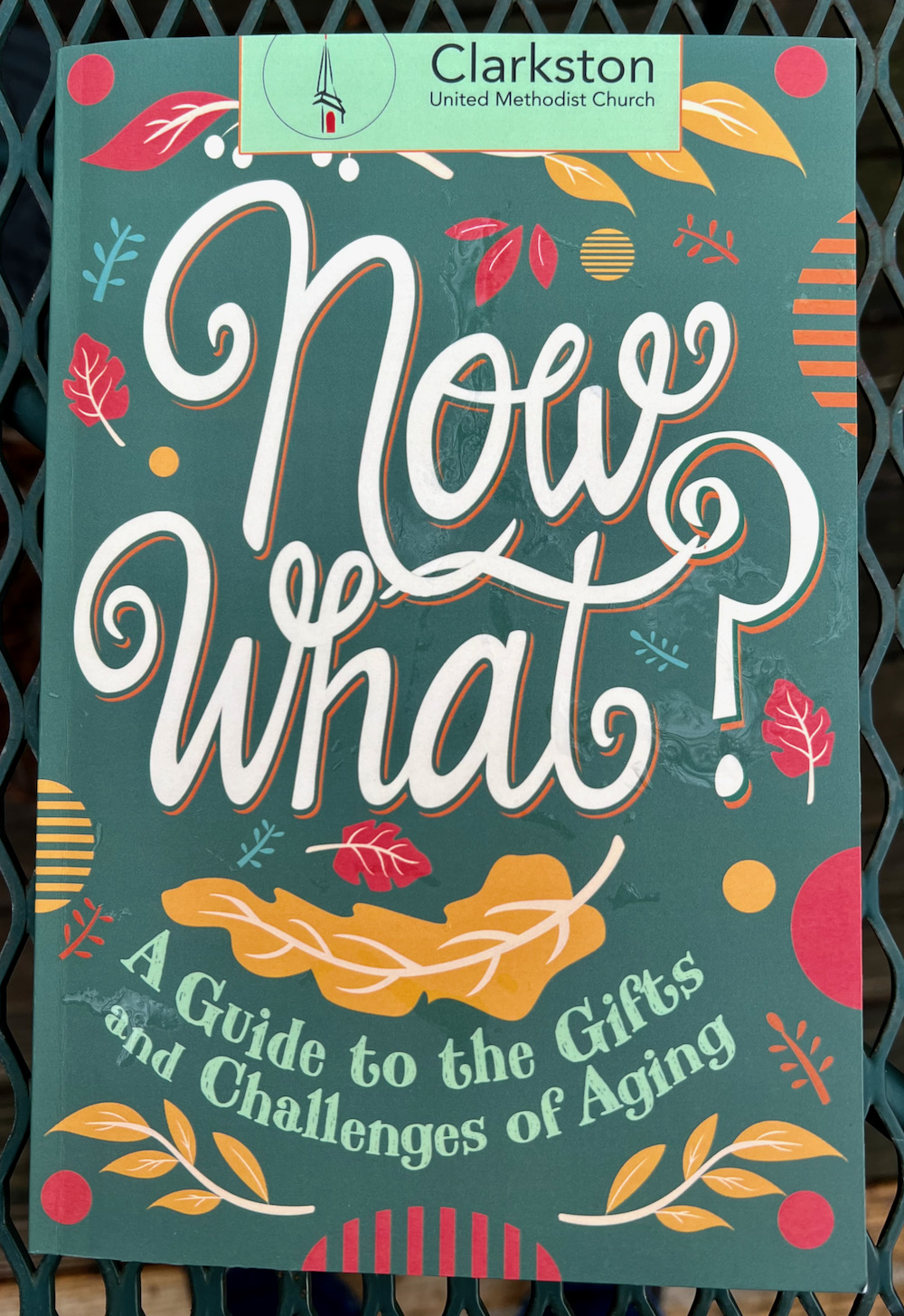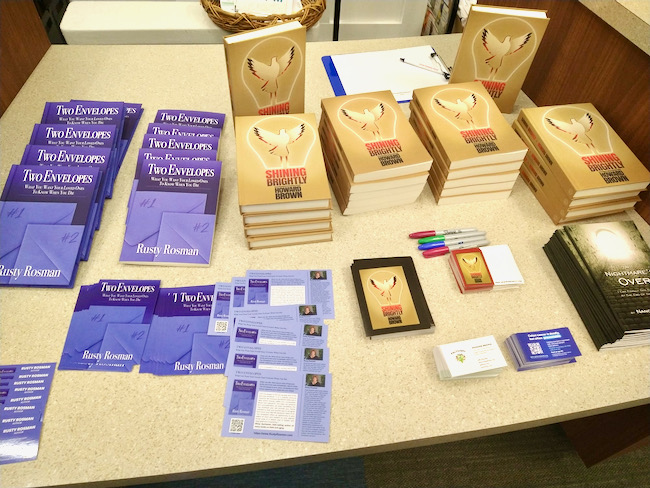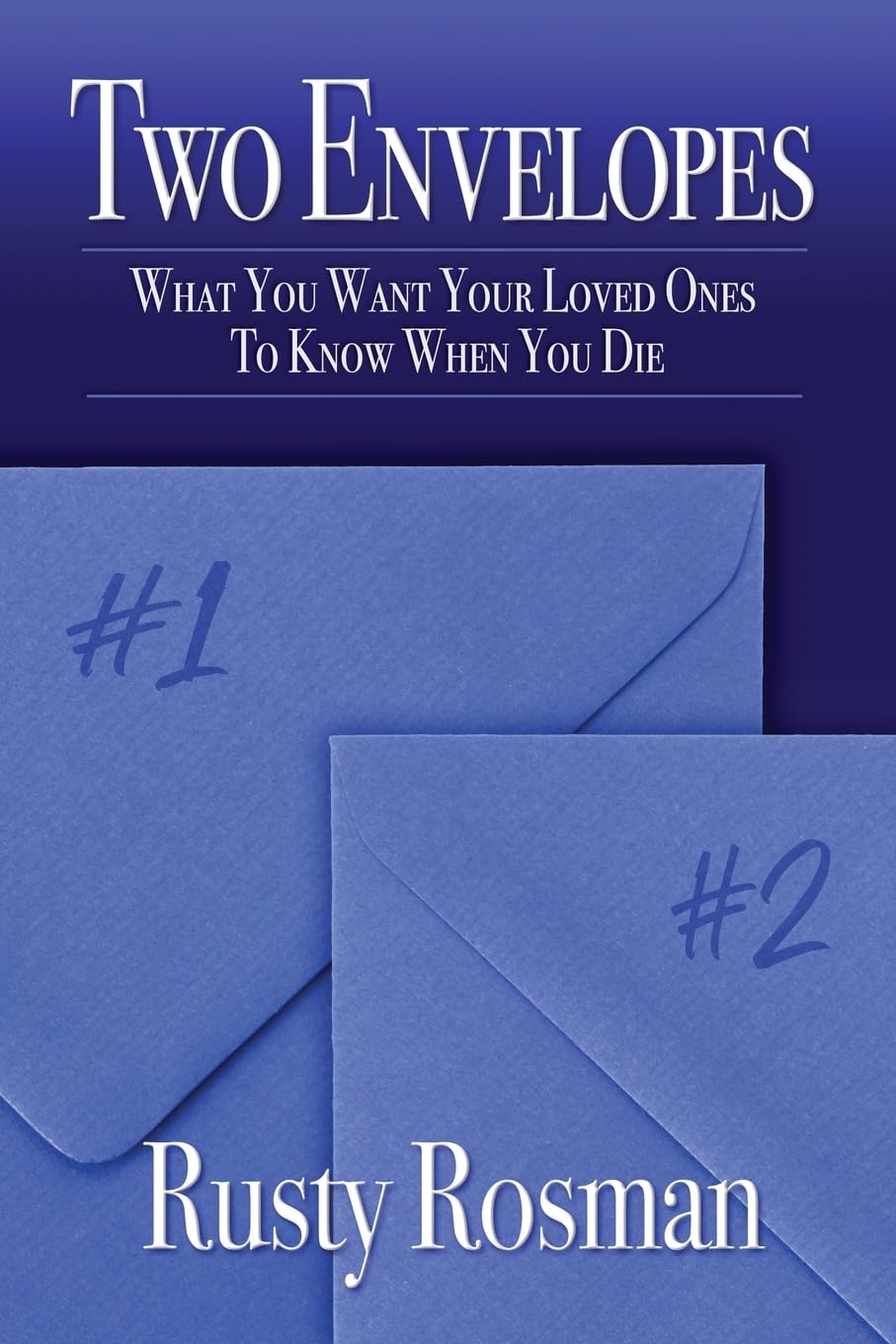
GENERATING FRESH IDEAS FOR THE ENTIRE COMMUNITY: Founding Editor David Crumm presents an Idea Incubator program at Clarkston United Methodist Church in Michigan. The church’s “gathering space” was set up with tables so participants could easily indicate their preferences for various ideas on survey sheets.
By DAVID CRUMM
Editor of ReadTheSpirit magazine
Seventy men and women packed the “gathering space” at Clarkston United Methodist Church in Michigan for an “Idea Incubator” about “The Gifts and Challenges of Aging.” That’s the subtitle of our book, Now What? It’s a valuable resource book written by experts in aging—packed with helpful and inspiring information about the many ways we can transform fears about aging into creative resilience as we mature.

IMAGINE YOUR GROUP’s LOGO ON THE COVER—This is the special Clarkston modified edition of the nationally released book Now What? If you click on this cover, you will visit the book’s main Amazon page. If you are interested in modifying a special edition for your community, we will be happy to talk with you about that—if you will email us at [email protected]
In preparation for that program, members of this very active church northwest of Detroit had ordered 70 copies of our book, adapted so that each copy was personalized for their congregation. Their church’s logo was on the front cover of each book distributed for the special program. Plus, the opening pages bound into this Clarkston edition are a two-page letter from their senior pastor, the Rev. Amy Mayo-Moyle. In her letter, Amy explained why this fresh approach to aging is in perfect harmony with the congregation’s mission statement: “Connecting people to people—and people to God.”
The distribution of these books—and an opportunity to take part in this unusual Idea Incubator—raised the enthusiasm in this community to a whole new level! Evidence of that was in participants’ glowing responses to the program’s organizers and speakers that night. They also expressed their interest on survey sheets. Plus, two of our authors who spoke during the program—Rusty Rosman and Howard Brown—sold far more of their books than any of us had expected.
We were surprised, in part, because everyone who participated that night already was reading their specially modified “Clarkston United Methodist Church” editions of Now What? As they arrived, we could see that their copies of that book were studded with bookmarks, Post-it notes and other markers.
Then, in addition to Now What?—they welcomed the idea of fostering future programs on various aspects of aging and caregiving. And, most of them went home with an additional book in their arms that they had decided to purchase, after the program, from Rusty or Howard.
That’s why we called this program an “Idea Incubator”—a way to lift up creative possibilities and build excitement.
It was a fitting way to use this special book. It was in keeping with the spirit of the 14 major organizations that came together just prior to the COVID pandemic—along with 15 expert authors—to develop Now What? Together, we assembled a rich collection of resources on everything from health and wellbeing to caregiving to funeral planning. The nonprofit network that created this resource intended it to be used by groups to generate ideas for new programs to help individuals and families. And, then, the pandemic hit. Public programs nationwide were cancelled. So, this week, the Clarkston church became the first to finally offer a public, in-person program exploring all of these “gifts and challenges.”
How did our Idea Incubator work?
As the General Editor of this book project from the start, I presented its most valuable ideas to the audience. For example, the first one I summarized was this one:
“People who care about their congregations—Christians, Jews and Muslims—hope to welcome more people. Here in Clarkston, you do, too. You hope to encourage more people to join you. Of course, you’ve got lots of reasons to encourage people: You’re warm, welcoming and inspiring. But, did you know that there also is solid, scientific evidence from around the world that connecting with a congregation actually is good for you? After two decades of public-health research, there’s now a global consensus that connecting with a congregation is a predictor of health, wellbeing and increased longevity. That may sound surprising, but it’s true: Secular research on the ‘social determinants of health’ concludes that the caring community connections we form in congregations will help us live happier, healthier and longer lives. It’s summarized in the heart of this book, Now What?—specifically look at chapters 9 and 10.”
At that point in the presentation, I watched as people in the audience pulled out their pens and made notes. Some people opened their books and moved bookmarks to those chapters so they could focus on them later.
After I listed this particular insight—the social determinants of health as they relate to congregations—I listed 13 more valuable ideas in this book for individuals and families. Each person at the event had been given a single sheet of paper with all 14 ideas listed. Below each idea, participants drew a “star” along a range of preferences from “No thank you, this one isn’t for me” to the opposite end of the spectrum: “I’m interested.” When we concluded, those sheets expressing the individual interests of everyone in the room were collected for the congregation’s leadership to consult as they plan future programs.
When they got that pile of responses, Amy and her leadership team could see at a glance that they represented many months of ideas to explore across the coming year. “There’s so much to look over and use here!” Amy said. “This definitely will be part of our planning process this year.”
How this event was organized
Clarkston United Methodist Church already has dozens of ongoing outreach programs and many “life groups”—plus classes, programs for children and youth, discussion circles and public-service projects in Michigan and abroad. That’s one reason we collectively chose this community for this first big program on Now What? We all knew that these folks in Clarkston would be wonderfully receptive.
The other reason we wound up at Clarkston was the encouragement of an “angel”—the term our publishing house uses for a community leader who steps up to ensure that book-related programs happen. Brenda DuPree is a longtime lay leader in the Clarkston congregation and she contacted me, because she remembered that our publishing house broadcast on this book’s national release date from the Clarkston church’s “gathering space.” At that point in the pandemic, we couldn’t host a big public event to launch the book. We needed to use Zoom—and the Clarkston staff volunteered its audio-visual resources to produce the elaborate Zoom event. For an hour, experts from across the nation shared ideas from this book across Zoom.
Brenda DuPree remembered that Clarkston connection with this book—and she realized that the resources in this book had never really reached as many people as we had hoped. So, with pandemic fears having subsided, she launched this new Clarkston planning project, and she also generously supported the whole effort for several months leading to our Idea Incubator this week. The event would not have been possible without Brenda’s tireless work as a local “angel.”
“Angels” like Brenda DuPree can make a huge difference across an entire community and now—with the publication of this ReadTheSpirit story about the event—nationwide.
What Brenda accomplished is exactly what all the expert-authors and nonprofit co-sponsors of this book had hoped.

This book table was shared by Rusty Rosman and Howard Brown at this event in Clarkston, Michigan. By the end of the evening, most of these books were heading home with men and women who were inspired by their talks—and were eager to read more.
Rusty Rosman and Howard Brown—’Shining Brightly’
Two authors who understood the importance of this program each agreed to give a short talk at the event—and both wound up far outshining my own presentation of the book’s core ideas.
Of course, I was not surprised. That is why I invited Rusty Rosman, author of Two Envelopes, and Howard Brown, author of Shining Brightly, to conclude our presentation with personal talks.
When Rusty began her talk, she started with the summary she uses with audiences nationwide (in person or via Zoom or podcast): “When you die, there are so many things your family and loved ones immediately need to know. Two Envelopes is your voice, conveying your final wishes regarding your death and your estate.”
She went on: “We know that three of the most emotional times in our lives are our marriage, birth of our children and the death of a loved one. We cannot predict how we will react at these times but our emotions come out whether we’re expecting them or not. Two Envelopes helps keep chaos at bay when dealing with the emotions of the death of your loved one.”
As she talked, I saw people across the room smiling and nodding their heads knowingly. They already knew what “chaos” can ensue when a loved one dies without ever expressing their wishes about what should come next.
Many people laughed when Rusty said that one of the thorniest questions for families is: “What will you wear when you’re dead?” As they laughed, many nodded. The question struck a personal cord.
She said, “One of the most emotional topics of family discussion when a loved one dies—and it can even become an argument—is what their loved one will wear for viewing and burial. Even if cremation is chosen, there often is a viewing before the final service.”
Then, Rusty told several stories about dear friends whose families had wrestled with such questions. This was emotional stuff! Rusty’s emotions reverberated in her voice. Emotions also were obvious in faces all across the “gathering space.” And, that’s why, when the program ended, a third of the people in attendance flocked to Rusty’s book table to buy copies of their book.
Clarkston already was planning programs later this year to discuss end-of-life decisions. The interest in this subject was clear cut in that crowd. We collectively hoped to heighten awareness of the importance of this subject across the whole community.
And, of course, Howard Brown’s conclusion of the program built on those emotions Rusty had stirred. A two-time survivor of life-threatening stage IV cancer, Howard simply told the story of several “miracles” that he has witnessed in his own life—because of personal resilience and because of the support of so many friends and family members.
Howard’s story was so moving that—at that point—the audience interrupted him for applause three times! None of us expected applause at such a program, but—at this point in the evening—it was clear we were talking about life-and-death issues close to the hearts of so many people in that room.
Similarly, when the program ended, a wave of people gathered around Howard and bought his Shining Brightly book to take home with them. Some people, in fact, bought both books. None of us expected such a heart-felt response!
Care to join us?
Is there an “angel” in your congregation—or your regional group, library or nonprofit—who would like to bring such a program to your community? A lot of planning and preparation went into that special night in Clarkston, but our publishing house is willing to plan such events with other interested groups in the future.
Contact us at: [email protected] or [email protected] Either email address will reach our offices.
Want to learn more about Rusty Rosman? Visit her website, RustyRosman.com
Want to learn more about Howard Brown? Visit his website, ShiningBrightly.com
Want to learn more about this remarkable congregation in Clarkston, Michigan? Visit their website.


